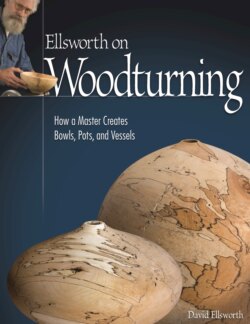Читать книгу Ellsworth on Woodturning - David Ellsworth - Страница 18
На сайте Литреса книга снята с продажи.
Types of burl growth
ОглавлениеThere are two fundamental types or patterns of burl growth that seem to be consistent within each species, meaning different species of trees will have one or the other type, but not both. The first type is the “classic,” or “pin,” burl; the second type is what I call an “onion” burl.
The classic, or pin, burl: The classic, or pin, burl is what most people are familiar with. In this pattern, the burl begins as a series of tiny sprouts all coming from one location near the tree's center. As the burl develops, these sprouts form lines, or "rays," that extend to the surface of the burl and are crossed by layer after layer of annual rings of the tree’s growth. This cross-grain structural pattern makes the burl wood extremely strong (you can’t split a burl), but I don’t believe it is any harder than the trunk wood.
If you cut a burl parallel to these rays, you can see how these rays extend from the burl's core to the surface and how they are crossed by the annual growth rings. It looks rather like a July 4 rocket explosion in the sky. But if you cut the burl across these rays, you get the classic “eye” configuration that you see so often in furniture veneer. When turning hollow forms, you get both patterns in the same piece.
The two fundamental burl growth patterns—classic and what I refer to as an onion growth pattern—plus a tiny root burl.
David Ellsworth, Redwood Burl Vessel, 1990. Redwood burl; 13" high x 15" wide x 15" deep. Collection: Robyn & John Horn. The holes in this piece were created by powder post beetles.
David Ellsworth, White Oak Pot, 2001. White oak; 13" high x 8" wide x 8" deep. This piece is made from what I call an onion burl. The piece was oriented with the top near the center of the burl and the base near the bark. This positioned the annual rings of the burl horizontally as they circled the form.
The onion burl: The second type of growth pattern is constructed somewhat like an onion, in that growth rings are arranged in a series of layers, one ring for each year of growth—just like in the trunk. This pattern is typical in white oak, yellow birch, and aspen burls. I once thought it would be fun to cut a burl in half and boil it up. If I could then separate each ring, I’d have lots of beautiful thin-walled bowls, one for each year of the burl’s growth. Never tried it.
Working with burls
Burls come in any number of sizes, shapes, and species, but the fundamental objective when working with burl materials is to remove all of the parts you know you don’t want so you’ll be left with what you do want.
Bowls and hollow forms can be located in a variety of positions in burls. Here are a few suggestions to get you started.
